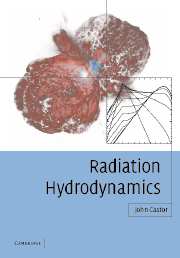Book contents
- Frontmatter
- Contents
- List of figures
- Preface
- 1 Introduction
- 2 A quick review of gas dynamics
- 3 Numerical hydrodynamics
- 4 Description of radiation
- 5 Steady-state transfer
- 6 The comoving-frame picture
- 7 Hydrodynamics with radiation: waves and stability
- 8 Radiation–matter interactions
- 9 Spectral line transport
- 10 Refraction and polarized light
- 11 Numerical techniques for radiation transport
- 12 Examples
- References
- Index
1 - Introduction
Published online by Cambridge University Press: 18 February 2010
- Frontmatter
- Contents
- List of figures
- Preface
- 1 Introduction
- 2 A quick review of gas dynamics
- 3 Numerical hydrodynamics
- 4 Description of radiation
- 5 Steady-state transfer
- 6 The comoving-frame picture
- 7 Hydrodynamics with radiation: waves and stability
- 8 Radiation–matter interactions
- 9 Spectral line transport
- 10 Refraction and polarized light
- 11 Numerical techniques for radiation transport
- 12 Examples
- References
- Index
Summary
Philosophy
The discipline of radiation hydrodynamics is the branch of hydrodynamics in which the moving fluid absorbs and emits electromagnetic radiation, and in so doing modifies its dynamical behavior. That is, the net gain or loss of energy by parcels of the fluid material through absorption or emission of radiation is sufficient to change the pressure of the material, and therefore change its motion; alternatively, the net momentum exchange between radiation and matter may alter the motion of the matter directly. Ignoring the radiation contributions to energy and momentum will give a wrong prediction of the hydrodynamic motion when the correct description is radiation hydrodynamics.
Of course, there are circumstances when a large quantity of radiation is present, yet can be ignored without causing the model to be in error. This happens when radiation from an exterior source streams through the problem, but the latter is so transparent that the energy and momentum coupling is negligible. Everything we say about radiation hydrodynamics applies equally well to neutrinos and photons (apart from the Einstein relations, specific to bosons), but in almost every area of astrophysics neutrino hydrodynamics is ignored, simply because the systems are exceedingly transparent to neutrinos, even though the energy flux in neutrinos may be substantial.
Another place where we can do “radiation hydrodynamics” without using any sophisticated theory is deep within stars or other bodies, where the material is so opaque to the radiation that the mean free path of photons is entirely negligible compared with the size of the system, the distance over which any fluid quantity varies, and so on. In this case we can suppose that the radiation is in equilibrium with the matter locally, and its energy, pressure, and momentum can be lumped in with those of the rest of the fluid.
- Type
- Chapter
- Information
- Radiation Hydrodynamics , pp. 1 - 4Publisher: Cambridge University PressPrint publication year: 2004



